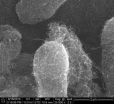(Press-News.org) This release is available in German.
Nanotechnology has developed tremendously in the past decade and was able to create many new materials with a vast range of potential applications. Carbon nanotubes are an example of these new materials and consist of cylindrical molecules of carbon with diameters of a few nanometers – one nanometer is one millionth of a millimeter. Carbon nanotubes possess exceptional electronic, mechanical and chemical properties, for example they can be used to clean polluted water. Scientists of the University of Vienna had recently published to this new research field in the well-known journal "Environmental Science & Technology".
Among many potential applications, carbon nanotubes are great candidate materials for cleaning polluted water. Many water pollutants have very high affinity for carbon nanotubes and pollutants could be removed from contaminated water by filters made of this nanomaterial, for example water soluble drugs which can hardly be separated from water by activated carbon. Problems due to filters' saturation could be reduced as carbon nanotubes have a very large surface area (e.g. 500 m2 per gram of nanotube) and consequently a very high capacity to retain pollutants. "Maintenance and wastes related to water depollution could thus be reduced", says Thilo Hofmann, Vice Dean of the Faculty of Earth Sciences, Geography and Astronomy of the University of Vienna.
Assessing carbon nanotubes' environmental sustainability
A lot of research has focussed on carbon nanotubes in the past decade. However, the exceptional properties of carbon nanotubes make them difficult to study. Standard methods give limited results and the behaviour of carbon nanotubes in realistic conditions is still poorly understood. "Innovative technologies always come with benefits and drawbacks for human and environmental quality and a good understanding of the interactions between contaminants and carbon nanotubes as well as how carbon nanotubes behave in the environment is essential before they can be used in filters", explains Mélanie Kah, who does research on this project together with Xiaoran Zhang.
A team of researchers at the Department of Environmental Geosciences at the University of Vienna is currently carrying out research on the subject. They developed a method called "passive sampling". Data produced by this new method are much more reliable for realistic applications as they include concentrations likely to occur in the environment (generally very low). This was not possible with classical methods that can only deal with elevated concentrations.
The experiments published now in the internationally recognised journal "Environmental Science & Technology" took more than a year. First, the "passive sampling method" was developed which allows measuring the affinity of a category of carcinogenic contaminants – i.e. Polycyclic Aromatic Hydrocarbons (PAHs) – to carbon nanotubes. "Series of tests which use analytical chemistry and electron microscopy were performed with collaborators from the University of Utrecht in the Netherlands, to ensure that the method is suitable, reliable and optimised for carbon nanotubes", illustrates Thilo Hofmann. Once validated, the "passive sampling method" was used to measure the affinity (absorption and adsorption) of several contaminants (PAHs) to carbon nanotubes over a very wide range of concentrations.
Contaminants fight for a place on carbon nanotubes
Another aspect investigated by the scientists of the Department for Environmental Geosciences is the phenomenon of competition between contaminants. Many chemicals often co-exist in the environment, especially in polluted bodies of water. If competition occurs, it means that a contaminant may not attach to carbon nanotubes if better competitors co-exist. Competition is not acceptable for filter application as the efficacy of the filter will vary according to the quantity and type of contaminants present. Studying competition also provides information on the mechanisms of sorption.
Using classical techniques with relatively high concentrations showed that competition can be very strong when three PAHs co-exist with carbon nanotubes. Conversely, experiments with the "passive sampling method" at concentrations likely to occur in the environment showed that no competition occurs if 13 PAHs are considered together. This example highlights the importance of developing and using experimental methods to produce results relevant to environmental conditions. There are still many questions to answer to fully evaluate the potential of carbon nanotubes to clean polluted water. "We keep on working on the subject and the results of our last experiments will be soon presented at international conferences", concludes the environmental geoscientist, Thilo Hofmann.
INFORMATION:
Publication
Measuring and Modeling Adsorption of PAHs to Carbon Nanotubes Over a Six Order of Magnitude Wide Concentration Range: Melanie Kah, Xiaoran Zhang, Michiel T.O. Jonker, and Thilo Hofmann. In: Environmental Science & Technology, 2011, 45 (14), pp 6011-6017. DOI: 10.1021/es2007726.
Nanotechnology for water filter
2011-07-22
ELSE PRESS RELEASES FROM THIS DATE:
Fingerprinting fugitive dust
2011-07-22
This release is available in Spanish.
Each community of soil microbes has a unique fingerprint that can potentially be used to track soil back to its source, right down to whether it came from dust from a rural road or from a farm field, according to a U.S. Department of Agriculture (USDA) soil scientist.
Ann Kennedy, at the Agricultural Research Service (ARS) Land Management and Water Conservation Research Unit in Pullman, Wash., studies the biological properties of soils that affect wind erosion. She analyses the soil for the fatty acid or lipid content from the community ...
Study: Subsidizing wages at long-term care facilities would cut turnover
2011-07-22
CHAMPAIGN, Ill. — Subsidizing the wages of caregivers at group homes would likely reduce worker turnover rates and help contain costs at long-term care facilities, according to new University of Illinois research.
Elizabeth T. Powers, a professor of economics and faculty member of the Institute of Government and Public Affairs at Illinois, says that a government-sponsored wage-subsidy program could reduce the churn of low-wage caregivers through group homes by one-third.
"High rates of worker turnover have costs, and there aren't a lot incentives for the agencies that ...
Stronger social safety net leads to decrease in stress, childhood obesity
2011-07-22
CHAMPAIGN, Ill. — Social safety net programs that reduce psychosocial stressors for low-income families also ultimately lead to a reduction in childhood obesity, according to research by a University of Illinois economist who studies the efficacy of food assistance programs on public health.
Craig Gundersen, a professor of agricultural and consumer economics at Illinois, says food and exercise alone are not to blame for the extent of obesity among children in the United States. Psychosocial factors, such as stressors brought about by uncertainty about the economy, income ...
Executive pay reform unlikely to reduce systemic risk in economy
2011-07-22
CHAMPAIGN, Ill. — Reforms aimed at curbing executive compensation will likely have little effect on reducing systemic risk in the financial system, and they may even have unintended consequences for the freedom to contract, according to a University of Illinois expert in business law and corporate finance.
In a paper published in the Ohio State Entrepreneurial Business Law Journal, law professor Christine Hurt argues that giving regulators unprecedented power to prohibit certain types of private compensation under the guise of minimizing systemic risk in the financial ...
Study: Regulatory hurdles hinder biofuels market
2011-07-22
CHAMPAIGN, Ill. — Regulatory hurdles abound for the successful commercialization of emerging liquid biofuels, which hold the promise of enhancing U.S. energy security, reducing greenhouse gas emissions and serving as a driver for rural economic development, according to new U. of I. research.
In the study, University of Illinois law professor Jay P. Kesan and Timothy A. Slating, a regulatory associate with the University of Illinois Energy Biosciences Institute, argue that regulatory innovations are needed to keep pace with technological innovations in the biofuels industry.
"Getting ...
Chance favors the concentration of wealth, U of M study shows
2011-07-22
Most of our society's wealth is invested in businesses or other ventures that may or may not pan out. Thus, chance plays a role in where the wealth of a society will end up.
But does chance favor the concentration of wealth in the hands of a few, or does it tend to level the playing field? Three University of Minnesota researchers have built a simplified model that isolates the effects of chance and found that it consistently pushes wealth into the hands of a few, ever-richer people.
The study, "Entrepreneurs, chance, and the deterministic concentration of wealth," ...
NASA sees Tropical Storms Bret and now Cindy frolic in North Atlantic
2011-07-22
Two tropical storms are now in the open waters of the North Atlantic: Bret and Cindy. Both were captured on one image from NASA today. Both storms are hundreds of miles to the east-northeast of Bermuda and pose no threat to land areas.
NASA's GOES Project issued an infrared image of both Bret and Cindy today from the GOES-13 satellite, which is operated by NOAA. The NASA GOES Project is housed at NASA's Goddard Space Flight Center in Greenbelt, Md. and uses GOES-13 data from NOAA to create images and animations. The image was captured at 0845 UTC (4:45 a.m. EDT) and shows ...
MIT: Inside the innards of a nuclear reactor
2011-07-22
CAMBRIDGE, Mass. -- As workers continue to grapple with the damaged Fukushima Daiichi nuclear powerplant in Japan, the crisis has shone a spotlight on nuclear reactors around the world. In June, The Associated Press released results from a yearlong investigation, revealing evidence of "unrelenting wear" in many of the oldest-running facilities in the United States.
That study found that three-quarters of the country's nuclear reactor sites have leaked radioactive tritium from buried piping that transports water to cool reactor vessels, often contaminating groundwater. ...
Is anesthesia dangerous?
2011-07-22
In pure numerical terms, anesthesia-associated mortality has risen again. The reasons for this are the disproportionate increase in the numbers of older and multimorbid patients and surgical procedures that would have been unthinkable in the past. This is the result of a selective literature review of André Gottschalk's working group at the Bochum University Hospital in the current issue of Deutsches Ärzteblatt International (Dtsch Arztebl Int 2011; 108[27]: 469-74).
In the 1940s, anesthesia-related mortality was 6.4/10,000. By introducing safety standards such as pulse ...
Grazing management effects on stream pollutants
2011-07-22
MADISON, WI, JULY 21, 2011 -- Surface water quality is important for the proper function of aquatic ecosystems, as well as human needs and recreation. Pasturelands have been found to be major sources of sediment, phosphorus and pathogens in Midwest surface water resources. While poor grazing management may lead to contaminated surface water, little is known about the specific amount of pollution in pasture streams that can be attributed to grazing cattle.
Scientists in the Departments of Animal Science, Veterinary Diagnostic and Production Animal Medicine, and Veterinary ...





